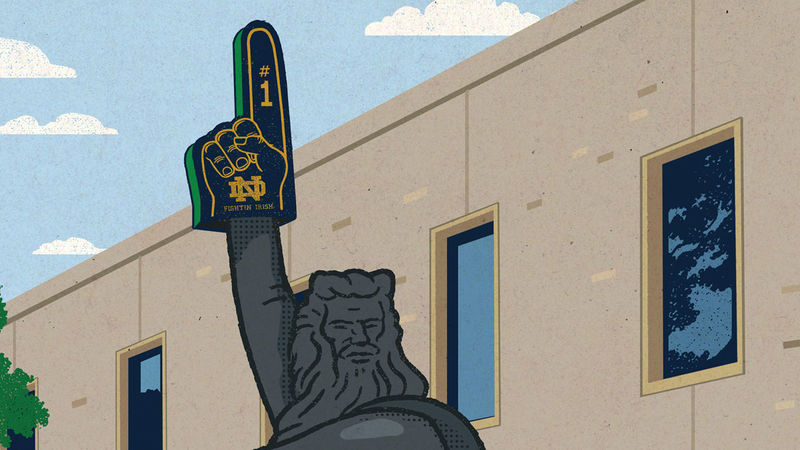The moment before kickoff at Notre Dame Stadium, when the Fighting Irish are clustered in their narrow tunnel waiting to be released, is exciting when seen on television and positively thrilling when witnessed live. It is the crescendo of a carefully orchestrated symphony, containing elements both traditional and sacramental: the player walk down Library Quad; the kneeling pregame prayer; the ritual slapping of the “Play like a champion today” sign. When those massive young men flood onto the field in their gleaming golden helmets, coursing down channels once followed by coaches and athletes whose names are our collective inheritance, you cannot help but feel that something momentous is about to take place. Ancient verities of honor, courage and the spirit of play are invoked without irony. College football demands that we not be cynical about such things.
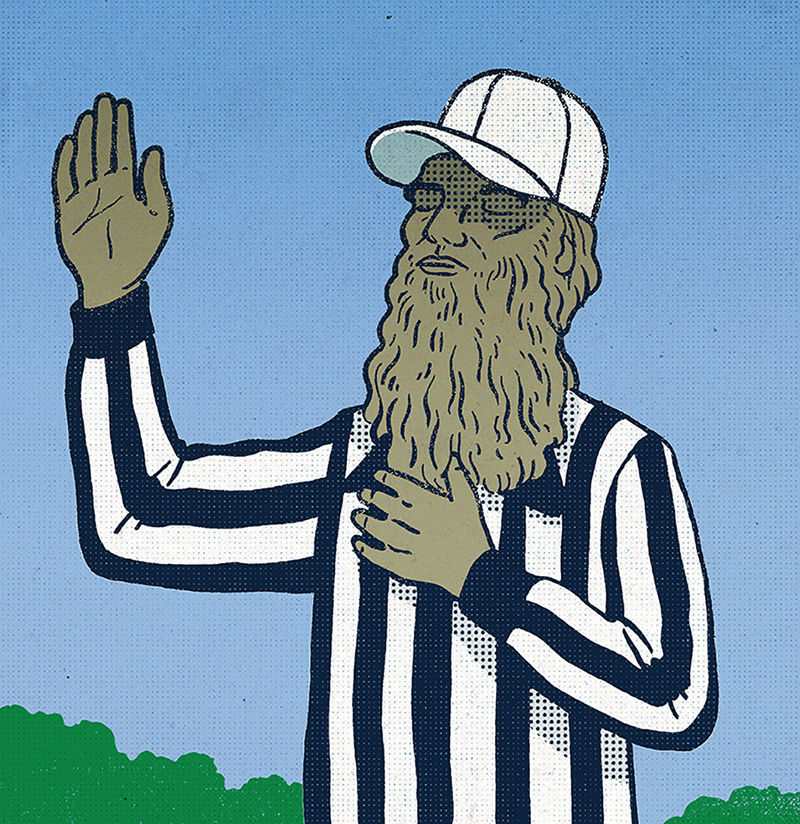 Illustrations by Dan Page
Illustrations by Dan Page
Yet for decades now, administrators, scholars, commentators and mere opportunists have questioned the growing role of sports in American higher education. The Rev. Theodore Hesburgh, CSC, the architect of the University we know today, was ambivalent about the beautiful and brutal game with which Notre Dame continues to be so strongly identified. He loved what it did for Notre Dame; he celebrated its victories; he feared the University might never escape its shadow.
Hesburgh, who served the University as president from 1952 until 1987, was founding co-chairman of the Knight Commission on Intercollegiate Athletics, whose first report, issued in 1991, acknowledged that “games and sports are educational in the best sense of that word because they teach the participant and the observer new truths about testing oneself and others, about the enduring values of challenge and response, about teamwork, discipline and perseverance.” Yet the same report warned that, “at their worst, big-time college athletics appear to have lost their bearings. With increasing frequency they threaten to overwhelm the universities in whose name they were established and to undermine the integrity of one of our fundamental national institutions: higher education.”
There is no elite school in America whose identity is yoked to sports in quite the same way that Notre Dame’s is. No other school has used athletics to lift itself to prominence in quite the way Notre Dame has, and no proper history of Father Sorin’s university would fail to reserve a chapter for Knute Rockne. If college sports are a devil’s bargain, no one has made a better deal than Notre Dame.
The University may soon be confronted — once again — with difficult questions about the role of sports on campus. The athletics department operates in an increasingly risky legal and compliance environment. More money is flowing through college sports than ever before, and with it temptations for coaches and players and the potential corrosion of institutional values. Meanwhile, pending legal challenges to the NCAA’s amateur model, if successful, threaten to alter the landscape significantly.
Notre Dame has contributed as much as any institution toward the creation of this college sports world. Because of that history, and because it continues to seek a leadership role, the University remains an active agent in the ongoing evolution of collegiate athletics. Before it can compete and win on the field, Notre Dame and like-minded schools must first create the conditions in which it makes sense for them to compete at all, given the actions of programs for which the drive to succeed is not freighted with the same educational and spiritual concerns.
The desire to compete at the highest level has long forced the University to make difficult choices. We can understand those choices in two ways. The first is to say that the University has charted a careful course, bowing to competitive realities only when necessary and seeking always to maintain the priority of its academic and religious mission. On these terms, Notre Dame has to be viewed as a remarkable success. Its scholarly profile has risen vertiginously even as the collective trajectory of its athletic programs has also moved upward.
The second way to look at it — a view shared by skeptics, critics of college sports and people who simply don’t like Notre Dame — is to say that beyond the façade Notre Dame is a big-time college sports school like any other.
Pay for play?
Unfortunately for Notre Dame in this era of seemingly perpetual academic and athletic success, college sports is in flux. The headlines tell the story. The NCAA is under increasing pressure both in the courts and from the public to permit revenue-sharing with student-athletes. What form that might take is not clear, and not all proposed approaches would necessarily destabilize the current system. However, if the NCAA were to allow direct payments from institutions to student-athletes, in effect abandoning the amateur model that it is charged to defend, then college sports could change very quickly — and Notre Dame would be forced to adapt.
In a 2015 interview with The New York Times, Rev. John I. Jenkins, CSC, ’76, ’78M.A. gave a clear indication of his views as University president. “Our relationship with these young people is to educate them, to help them grow,” he said. “Not to be their agent for financial gain.” Jenkins told the Times that Notre Dame would not participate in a system in which college athletes were paid as employees, erasing the distinction between college and professional sports (although he was open to student-athletes monetizing their fame in other ways).
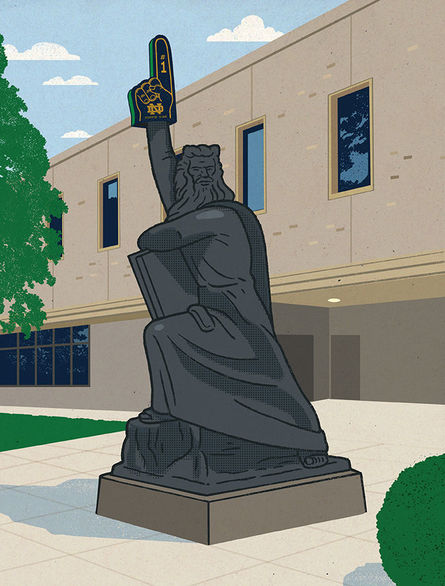
Athletics Director Jack Swarbrick ’76 voices similar sentiments. “This debate is one about whether you like the particular form of compensation,” he says. “Of course our student-athletes are compensated, but the compensation is in the form of educational benefits — the full cost of attendance at Notre Dame, which is what a full grant-in-aid covers, is now roughly $70,000 a year.” Swarbrick also is not opposed to seeing players share in revenues generated by the use of their names and likenesses. But to go to an open-market system in which schools compete for players through salary offers would cross a line. “We’re committed to the educational mission first and foremost,” he says.
If necessary, Swarbrick has suggested that Notre Dame might seek to form a conference of institutions such as Stanford, Northwestern, Rice and the service academies to maintain the current amateur model. It is impossible now to say precisely what such a conference would look like, or whether a substantial number of institutions would join Notre Dame in exiting the NCAA. Conference relationships and TV contracts would have to be unwound. And some of the schools that Swarbrick mentioned have invested hundreds of millions of dollars in stadiums secured by the promise of future revenues.
Swarbrick believes there would be considerable fan interest in an amateur conference and that the economics would not (as I suggested to him) drift inexorably toward the Ivy League’s aging stadiums and limited television exposure. Now in his 11th year as athletics director, the Stanford-trained lawyer spent 28 years advising sports-industry clients and is regarded as one of the smartest people in college sports. I wouldn’t bet against him.
It does seem reasonable to assume, however, that Notre Dame likely would no longer compete at the highest levels in football and men’s basketball. It might still attract strong athletes, but those wanting the best competition in preparation for pro careers would likely go elsewhere. If Notre Dame ceased to be relevant competitively, its fan base would shrink, it likely would lose its national TV contract in football, and revenues would begin to decline — potentially entering a downward spiral that could impact the nonrevenue sports, which benefit enormously from the cross-subsidy that football and men’s basketball provide.
The legal threat to the amateur status of college athletes and the NCAA’s cap on scholarship aid to student-athletes is significant and growing. (The cap limits scholarships to coverage of tuition, fees, room, board and minor expenses like traveling home for holidays: the “cost of attendance.”) The organization narrowly avoided disaster as recently as 2016 in a case brought by former UCLA basketball star Ed O’Bannon, who on behalf of a group of current and former college athletes was seeking compensation for the NCAA’s commercial uses of their images, principally in video games.
After a highly publicized trial, U.S. District Judge Claudia Wilken ruled for O’Bannon. Her opinion called into doubt a long line of authority, originating in a 1984 Supreme Court case, which holds that the NCAA’s scholarship caps and its ban on other forms of compensation for college athletes are indispensable to the amateur model — and therefore do not violate the provisions of U.S. antitrust law that target unfair restraints on trade. The Ninth Circuit Court of Appeals reversed this ruling, preserving the status quo for now. (The trial in another case before Wilken that more directly challenges the scholarship caps finished in September, and her opinion was expected any day as the magazine went to press in December.)
Professor Thomas A. Baker of the University of Georgia, who writes frequently on the intersection of sports and antitrust law, thinks the NCAA’s “student-athlete” rhetoric is a fig leaf to cover what at heart is an entertainment-business model. “I’m not an anti-NCAA zealot,” he says. “But I’m in favor of the rational application of antitrust law. My research shows that consumers don’t really care about ‘amateurism’ per se. Look at the Olympics — everyone predicted that when the IOC changed its rules to permit professionals to compete, interest in the Games would decline. Guess what? It didn’t happen.”
Professor Baker acknowledges that federal courts, protective of their own institutional legitimacy, may be reluctant to take measures that could destabilize college sports. “I don’t expect the impetus to come from the courts,” he says. “Public pressure, or direct action from athletes, is more likely to bring about change.”
Swarbrick takes the legal threat seriously. “I think we will have some significant change dictated to us by the courts,” he says. “NCAA member institutions simply provide too many examples of people not following the model we’re in court trying to defend.”
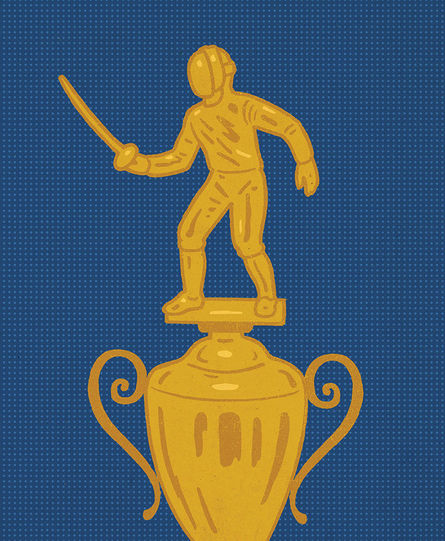
Yet he is more optimistic about the long term. “I think the fundamental educational basis of our model will hold fast,” he says. That could take the form of federal legislation protecting the existing model. It could also mean incremental reforms that allow players to tap into additional revenue streams such as apparel sales (with the monies perhaps held for the player in trust) without moving to a full pay-for-play system.
In the end, non-legal challenges might prove to be the greater threat as the NCAA struggles to answer questions about its credibility. It has not gone unnoticed that the majority of the players in the revenue-producing sports are African-American or that it is these athletes who arguably are undercompensated under the current model.
Everyone around college sports seems to be waiting for the other shoe to drop. In 2014, Northwestern University football players sought, somewhat quixotically, to form a union to negotiate with their school. The National Labor Relations Board declined to certify the union, citing NCAA rules and the risk of destabilizing college sports by treating scholarship athletes as employees. And in 2016, the University of Wisconsin men’s basketball team, led by athlete-activist Nigel Hayes, very nearly staged a work stoppage — that is, refused to play a scheduled Badgers game — in protest of what they believed was a rigged system. They ultimately decided to take the floor, and the current system held — for now. But a collegiate Colin Kaepernick might yet catalyze what is now mostly sub rosa student-athlete discontent into a movement.
Athletes, students
Allen Sack ’67 played defensive end for Ara Parseghian, at times lining up alongside his classmate Alan Page on teams that were among the best in the country. After graduating from Notre Dame, Sack earned a doctorate in sociology from Penn State and is now professor emeritus of business at the University of New Haven. His 2008 book, Counterfeit Amateurs: An Athlete’s Journey Through the Sixties to the Age of Academic Capitalism, is both a memoir of his playing days and an indictment of the state of college sports.
Sack believes the demands placed on Division I athletes are largely incompatible with high academic achievement. “I was part of an athletic system finely tuned for producing a national championship team,” he writes, but “compared with corporate-driven college sports in the new millennium, my early experiences at Notre Dame seem quaint.”
The admissions gap between NCAA student-athletes and their peers, as measured by high school GPAs and standardized test scores, has grown in recent decades. The time Division I athletes devote to training, practicing and studying film has also grown, despite NCAA rules that formally limit the hours athletes may spend on required team activities.
Nowhere are the pressures greater than at Notre Dame. Coach Brian Kelly acknowledged the challenge in a 2015 media session: “All of my football players are at-risk [academically] — all of them, really. Honestly, I don’t know that any of our players would get into the school by themselves right now with the academic standards the way they are. Maybe one or two of our players that are on scholarship.”
“The kid has to buy in,” says David Peloquin ’03, the football team’s director of player personnel. “They have to want the Notre Dame experience, which means the academics, the expectations, all of it. Coach Kelly always tells us, ‘Keep it real.’ Because there’s no point bringing a kid in under false pretenses. That’s not going to work out for anyone.”
Peloquin maintains an open dialogue with the admissions office. “They understand our needs and we understand what they’re trying to do, too, which is to fill every entering class with the best possible students. That’s a challenge we accept,” he says. “We want guys to succeed in the classroom and we want them to graduate.”
Many alumni believe, perhaps on the basis of the football program’s uneven record in recent decades, that the University acts strategically with respect to athlete admissions, loosening standards as needed to maintain on-field competitiveness. The administration has always denied this. Lou Holtz, who won big at Notre Dame, complained bitterly that the admissions office would not relax its standards. “When coaching candidates come to interview here,” Swarbrick says, “I always identify a number of things about the Notre Dame experience that are not going to change. Things like the residentiality requirement, the administration of student discipline and drug testing outside of athletics, and the autonomy of the admissions process. Honestly, we’ve had some attractive candidates walk away over those issues. But it’s better to be upfront about expectations, because they’re not going to change.”
Women's programs feature everything that purists love about sports: deep focus, discipline, teamwork. What is missing from most are the corrupting influences of money and fame.
Academic Services for Student-Athletes (ASSA), a department of the provost’s office, is charged with helping student-athletes overcome their disadvantages and make steady progress toward their Notre Dame degree. Nick Mainieri ’06 played baseball at Notre Dame as a walk-on for his father, Paul. He is now a senior academic counselor in ASSA, working with the baseball, women’s soccer and fencing teams, having left a tenure-track teaching position at Nicholls State University to return to his alma mater. Since his athletes are often in practice or meetings well into the evening, Mainieri, who is married and has a 3-year-old son, finds himself taking phone calls or exchanging texts with them at night. “We’re trying to get them to realize their full potential as students,” he says. “Sometimes it takes a year or two for the light to come on — for them to fully appreciate the opportunity they have.”
Most student-athletes at Notre Dame have a positive experience. Graduation rates in football and other programs remain at or near the top of Division I statistics. Nonetheless, Swarbrick recently directed his staff to look for patterns in the backgrounds of student-athletes who left without their degrees. (The answer: Every story seemed unique.) Why do the study? “Father Jenkins always says that we have a moral obligation to these young men and women to make sure they succeed in all phases, including academics,” he says. “If there are ways we can improve the process, we ought to do that.”
The NBC deal
The United States is the only nation that ties a vast TV entertainment spectacle to its leading academic institutions. College sports are one of our exceptionalisms, as American as action movies, evangelical religion and muscle cars. They fit the larger cultural landscape.
I do not claim that football couldn’t have been invented elsewhere. I doubt, however, that any other people could love it as we do or find so much of ourselves reflected in it. An abstract argument that college sports are corrosive of a university’s intellectual mission stands no chance against the emotional fervor, not to mention the cash, that the games generate.
Since 1991, NBC has broadcast every Notre Dame home football game — roughly 185 and counting. The NBC-Notre Dame contract has now been extended through 2025 at a reported annual value of $15 million to the University. This unique relationship, which began amidst both competitors’ resentments of Notre Dame’s special treatment and skepticism that NBC would stick with the deal if the Irish didn’t win big on the field, has served the school well, and not just in football.
“There is a high level of trust between NBC and Notre Dame,” associate athletics director Rob Kelly ’03 says. “They have been a great steward of our brand” — without any substantial input from the University into the way the games are presented. Swarbrick says Notre Dame has not sought such input, and it is unlikely that NBC would permit it. “Other athletic directors tell me that their game with Notre Dame is the best-produced broadcast of their season. NBC is not the Notre Dame football network. The games have to reach a big audience or the relationship doesn’t work for anyone,” he says.
The broadcast belongs to NBC, and yet Notre Dame as presented by NBC is an almost perfect reflection of how the University wants to be seen by others. Indeed, the “Fighting For” institutional spots, while often affecting, are almost superfluous, because the games themselves effectively function as advertising. Through NBC, the University reaches many carefully cultivated audiences — the alumni, prospective students, American Catholics, the wider academic world.
No surprise, then, that other schools and conferences followed with lucrative TV deals of their own, which in most cases have offered even greater control over message along with the new revenues. These deals are in many ways more ambitious than Notre Dame Football on NBC. The University of Texas and ESPN invested $300 million in the Longhorn Network, which launched in 2011 and shows games from 20 UT sports along with ESPN programming. The SEC Network was founded in 2014 and now has an estimated market value of over $5 billion, fueled by the tremendous interest in SEC football. All this TV money, and the enormous coaching salaries and lavish stadiums, consort uncomfortably with the amateur ideal to which the players are held. This is the college sports world that Notre Dame helped make — and it is the world that it now has to exist and adapt within.
Attracting recruits
The facilities arms race in college athletics makes even some hardened fans uncomfortable. Increasingly, highly recruited athletes expect not just large game-day venues and state-of-the-art training facilities but perks like barbershops, indoor miniature golf courses and ventilated lockers. The University of Texas recently spent $7 million to upgrade its football locker room. Each personalized locker cost $8,700 and features a 43-inch video monitor. Providing these extras is a logical response to the scholarship caps imposed by the NCAA. “A scholarship is a scholarship no matter where you go,” Texas coach Tom Herman has said. “It’s about how you differentiate yourself.”
The spending is not limited to the traditional powers. Northwestern, a private school with academic standards similar to Notre Dame’s, is the smallest competitor in the Big Ten and has a relatively limited history of football success, to put it politely. Last summer, the school unveiled a $260 million football practice facility (usable by other Wildcat teams), a futuristic, glass-enclosed structure with sweeping views of Lake Michigan. Similarly, the University of Kansas, which has not won a conference football title since the Big 12 began play in 1996, recently committed $315 million to replace its aging stadium. It does not seem unreasonable to ask whether some of that money might have served better purposes.
When Kevin White became Notre Dame’s athletics director in 2000, he recognized that many facilities were inadequate and the administration would have to make a serious investment to stay competitive. Under White, who is now at Duke, and his successor, Jack Swarbrick, Notre Dame has spent freely to bring its stadiums and practice facilities up to date. Much of this money has come from alumni donors, as with the Compton Family Ice Arena, a $50 million, 5,000-seat facility that in 2011 replaced a smaller, dilapidated rink then housed in the Joyce Center. The lacrosse facilities have been upgraded, the Guglielmino Athletics Complex was added in 2008, and a new indoor football practice facility will open next summer. Tennis is likely next. The Eck Tennis Pavilion, enviable when it opened in 1987, is badly out of date.
Amidst the spending, one detects a deliberate effort by the administration to maintain some decorum. The $400 million Campus Crossroads project, for example, blended a renovation of Notre Dame Stadium with a new student center and classroom and faculty space. “The athletics department isn’t a separate enterprise,” Swarbrick says. “We’re fully integrated into the University.” The new facilities are spacious and well-appointed, functional rather than extravagant. The truth is that the kind of recruit lured by the prospect of a TV above his locker almost certainly isn’t interested in Notre Dame anyway — though he might line up for an opponent a couple of years down the road.
Speaking for myself, if Notre Dame is going to compete, I want its teams to win (though I cannot quite persuade myself that it is a matter of great metaphysical importance whether they do). It is fair to ask, though, whether Notre Dame should be trying to compete with institutions that are not prepared to impose any limiting principles on the hypertrophied glitz and commercialism of college sports.
The Title IX mystique
If you want to stop even the sharpest critics of college sports in their tracks, invoke Title IX, the 1972 legislation that prohibits gender discrimination at institutions that receive federal funds.
Despite some unintended negative consequences, Title IX has been a major success. Women’s programs feature everything that purists love about sports: deep focus, discipline, teamwork. What is missing from most are the corrupting influences of money and fame.
Notre Dame, which embraced coeducation the year Title IX passed, adopted the new regime without reservation and has reaped enormous returns. Graduation rates among women athletes are high, and the on-field results speak for themselves: 12 national championships across basketball, soccer and fencing (where a single title is awarded based on the combined performance of the men’s and women’s teams), and consistently strong performances in tennis and lacrosse. Notre Dame’s women athletes are equaling or exceeding their male counterparts in almost every metric except fan interest and media coverage.
Speaking for myself, if Notre Dame is going to compete, I want its teams to win. It is fair to ask, though, whether Notre Dame should be trying to compete with institutions that are not prepared to impose any limiting principles on the hypertrophied glitz and commercialism of college sports.
On a cold, clear October night last year, I attended a women’s soccer game against No. 3 North Carolina at Alumni Stadium. Despite a down year for the Irish, the crowd, made up mostly of families with young girls and an impressive contingent of visiting UNC fans in Carolina blue, was impressive for a weeknight regular-season game. Notre Dame cheerleaders were there, as was one of the more than half a dozen leprechauns.
Notre Dame and North Carolina have produced two of the strongest women’s soccer programs. Notre Dame has won three national championships, UNC an astonishing 22. The game was played at a fast tempo and a consistently high level of skill. UNC was the more experienced team, better organized, more patient and secure in their first touches.
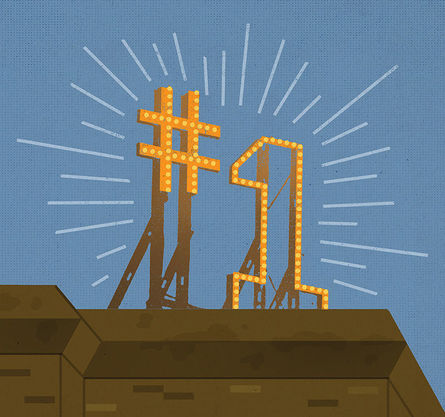
To my eye, though, Notre Dame was playing a little bit harder, even after falling behind on a Tar Heel goal in the opening minute. Facing dispiriting odds, the underdog Irish might have quit, but they didn’t, and I found myself pulled into the contest in a way I hadn’t expected, given how little I understand soccer. For long stretches, Notre Dame had the better of the play.
Carolina ultimately won, 2-1 — a disappointment, and in a way even an injustice, or at least a sports cliché betrayed, that of the plucky underdog who triumphs in the end. Nonetheless I left feeling curiously happy. Football exerts an enormous gravitational pull in any conversation about Notre Dame, in my house as anywhere else. But this contest was exciting as hell, played near the uppermost level of the sport — for joy, for teammates, for the name on the front of the players’ jerseys.
So set football aside if it doesn’t suit your temperament. This game matters, too.
The path ahead
Any argument about Notre Dame sports is also inevitably a proxy for competing visions of what Notre Dame is or could be as a university. De-emphasizing football in particular likely would make some vocal constituencies very unhappy. In asking Notre Dame to reconsider its place in a college sports world marked by increasing professionalization, Father Jenkins would be appealing to the academic and spiritual legacy of the University — in effect, to Notre Dame’s loftiest self-conception. These values are impossible to quantify in a society that increasingly credits only what it can measure, and they are decidedly in retreat in the broader culture.
Notre Dame finds itself in the uncomfortable position of defending an unstable status quo. If the NCAA can do a better job policing corruption; if it can figure out a rational way to share revenues with athletes that does not make them professionals; if it can awaken in the public a renewed appreciation for the amateur ideal, then perhaps the current system can be saved.
Your view of whether it is worth saving may turn on how much beauty and inspiration you find in the games. Rockne and Frank Leahy believed that football was endowed with heroic properties. Others believe that large sports arenas have no place on college campuses and that the connection between sports and education is attenuated at best. These visions are not compatible. What Notre Dame must decide is the place sports should have now at a school that is in many ways better, and without doubt more worldly, than it was when Rockne and Leahy stalked the sidelines. It may be, as the critics suggest, that a Notre Dame without a Notre Dame Stadium would be an institution with a purer sense of mission. It might also be a community that had lost some measure of its inimitable spirit.
Jonathan Clarke is a lawyer, essayist and critic living in Brooklyn, New York.
